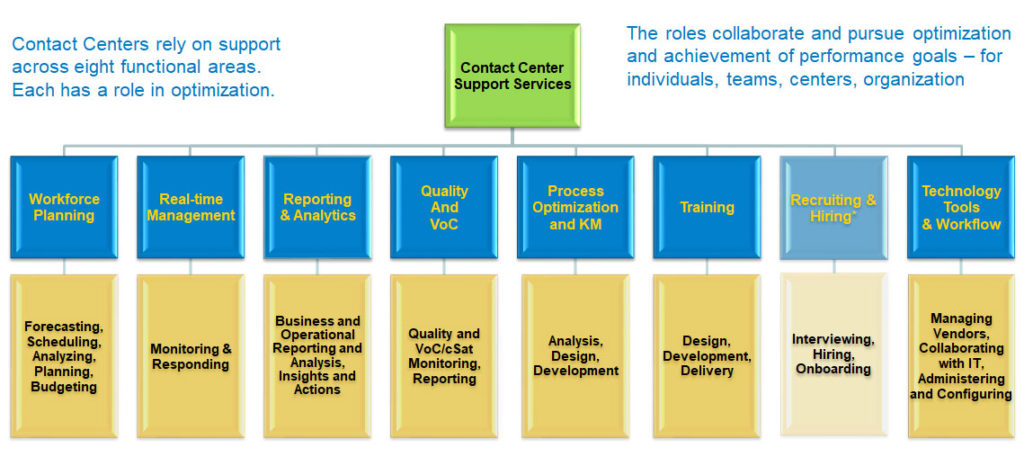Strategic Contact conducts many assessment and roadmap projects each year. Support functions represent one element that we evaluate according to the following model:

We assess whether the center addresses each function and, if so, by whom and how well. Almost without exception, we uncover gaps that lead to recommendations to fulfill these essential roles.
In small centers, we may be asking (if not begging) for one – just one – Analyst to free up Supervisors to do their day jobs (including routinely coaching!), or simply to make sure these vital tasks get handled. Let’s face it: Supervisors and Managers moonlighting as Analysts doesn’t work! They don’t do it well, routinely, fully, or at all.
Larger centers may have one or two Analysts, perhaps for QM or WFM, but often need more, particularly for knowledge management and process optimization. When staffed, this resource works closely with training, QM, and Supervisors to fine tune the tools and processes in service of contact handling excellence.
The Analyst gap has become increasingly evident as we work on cloud technology projects. These initiatives equip centers with better tools for reporting, analytics, monitoring, WFM, et al without the usual dependencies on IT. However, without an Analyst, they don’t have the means to reap the benefits of the available insights to support day-to-day work and to plan and optimize operations. The smart money places the Analyst on-board for implementation and then recoups that investment in a revitalized center going forward.
In their perennial vigilance over managing (minimizing) headcount, contact center leaders routinely mount resistance to funding Analyst positions. They may try to tack it on to Manager or Supervisor duties. They may give it to an enterprising Team Lead but then fail to backfill that person’s frontline role. Or they might try to graft it onto the few support resources that are already in place. The results inevitably fall short.
Another form of magical thinking revolves around the false belief that resources in another department will pick up the slack – e.g., the Business Intelligence Team, the IT Team, project management, training. Even with the best intentions, this approach falls short. During implementation, these resources tend to focus on the technology and project timeline. Post-implementation, they tend to get pulled into the corporate vortex of products, sales projections, revenue analysis, other projects, etc.
We’d be the first to admit that “something is better than nothing” for support staffing. If that’s the reality, then the designated personnel should have time allocated to the assigned tasks. Ideally, they should be embedded in the center – physically, if onsite, and via a clear reporting relationship regardless. The parties should agree on routine deliverables and meetings aligned with the support functions assigned.
My plea to contact center leaders and their chain of command is to take a serious look at funding the right resources to use technology, optimize processes, and provide the necessary support to enable employees to do their jobs well. There is a business case for it in terms of reduced volumes and handle times, schedule efficiency that reduces staff needs, and lower burdens for hiring and training. Moreover, putting these resources in place provides tangible evidence of the center’s commitment to the customer and employee experience. It says the company is going to find the best ways to drive efficiency and effectiveness in contact handling.
